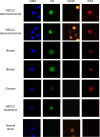Isolation of Circulating Tumor Cells from Multiple Epithelial Cancers with ApoStream(®) for Detecting (or Monitoring) the Expression of Folate Receptor Alpha
- PMID: 26848256
- PMCID: PMC4737520
- DOI: 10.4137/BMI.S35075
Isolation of Circulating Tumor Cells from Multiple Epithelial Cancers with ApoStream(®) for Detecting (or Monitoring) the Expression of Folate Receptor Alpha
Abstract
This study describes our efforts to further the field of noninvasive diagnostics, specifically in the area of liquid biopsies in oncology. We employed laser scanning cytometry using highly selective antibodies to interrogate circulating tumor cells (CTCs) that were isolated using ApoStream(®) technology to identify folate receptor alpha (FRα)-positive cells. We demonstrate that FRα(+) CTCs can be isolated from patients with metastatic cancers, including NSCLC adenocarcinoma, breast cancer, and ovarian cancer, whereas squamous cell lung cancer and normal healthy controls were devoid of FRα(+) CTCs. We believe that the developed methodology will have applications in both the diagnosis and the monitoring of FRα-expressing cancers. Folate receptor alpha (FRα) expression may have utility as a potential diagnostic and therapeutic target in solid tumors. As tissue samples are not always available for patient screening, this study evaluated a noninvasive assay in CTCs from blood samples to detect FRα expression. The presence of FRα(+) CTCs enriched using ApoStream(®) and detected using laser capture cytometry was evaluated in blood samples from cancer patients [NSCLC adenocarcinoma (n = 14), breast cancer (n = 20), ovarian cancer (n = 6), and squamous lung cancer patients (n = 6)] and healthy subjects (n = 20). The data demonstrated that FRα(+) CTCs were detected in blood from NSCLC adenocarcinoma, breast, and ovarian cancer patients, whereas squamous cell lung cancer patients and normal healthy controls lacked FRα(+) CTCs as previously known. We demonstrate that CTCs captured using ApoStream(®) can be used to detect FRα(+) CTCs and may have clinical utility as a real-time liquid biopsy for assessing FRα levels in cancer patients.
Keywords: ApoStream®; CTC; folate receptor alpha; liquid biopsy; solid tumors.
Figures





Similar articles
-
Combined use of EpCAM and FRα enables the high-efficiency capture of circulating tumor cells in non-small cell lung cancer.Sci Rep. 2018 Jan 19;8(1):1188. doi: 10.1038/s41598-018-19391-1. Sci Rep. 2018. PMID: 29352248 Free PMC article.
-
Antibody-independent capture of circulating tumor cells of non-epithelial origin with the ApoStream® system.PLoS One. 2017 Apr 12;12(4):e0175414. doi: 10.1371/journal.pone.0175414. eCollection 2017. PLoS One. 2017. PMID: 28403214 Free PMC article.
-
Quantitation of rare circulating tumor cells by folate receptor α ligand-targeted PCR in bladder transitional cell carcinoma and its potential diagnostic significance.Tumour Biol. 2014 Jul;35(7):7217-23. doi: 10.1007/s13277-014-1894-0. Epub 2014 Apr 27. Tumour Biol. 2014. PMID: 24771263
-
The folate receptor as a rational therapeutic target for personalized cancer treatment.Drug Resist Updat. 2014 Oct-Dec;17(4-6):89-95. doi: 10.1016/j.drup.2014.10.002. Epub 2014 Oct 8. Drug Resist Updat. 2014. PMID: 25457975 Review.
-
Biology and clinical significance of circulating tumor cell subpopulations in lung cancer.Transl Lung Cancer Res. 2017 Aug;6(4):431-443. doi: 10.21037/tlcr.2017.07.03. Transl Lung Cancer Res. 2017. PMID: 28904887 Free PMC article. Review.
Cited by
-
Detection, significance and potential utility of circulating tumor cells in clinical practice in breast cancer (Review).Oncol Lett. 2024 Oct 17;29(1):10. doi: 10.3892/ol.2024.14756. eCollection 2025 Jan. Oncol Lett. 2024. PMID: 39492933 Free PMC article. Review.
-
Molecular characterization of circulating tumor cells in lung cancer: moving beyond enumeration.Oncotarget. 2017 Nov 23;8(65):109818-109835. doi: 10.18632/oncotarget.22651. eCollection 2017 Dec 12. Oncotarget. 2017. PMID: 29312651 Free PMC article. Review.
-
Detection of folate receptor-positive circulating tumor cells by ligand-targeted polymerase chain reaction in non-small cell lung cancer patients.J Thorac Dis. 2016 Jul;8(7):1437-9. doi: 10.21037/jtd.2016.05.38. J Thorac Dis. 2016. PMID: 27501215 Free PMC article. No abstract available.
-
Microfluidic-Based Technologies for CTC Isolation: A Review of 10 Years of Intense Efforts towards Liquid Biopsy.Int J Mol Sci. 2022 Feb 10;23(4):1981. doi: 10.3390/ijms23041981. Int J Mol Sci. 2022. PMID: 35216097 Free PMC article. Review.
-
Folate Receptor Alpha-A Novel Approach to Cancer Therapy.Int J Mol Sci. 2024 Jan 15;25(2):1046. doi: 10.3390/ijms25021046. Int J Mol Sci. 2024. PMID: 38256120 Free PMC article. Review.
References
-
- Clifford AJ, Arjomand A, Deuker SR, et al. The dynamics of folic acid metabolism in an adult given a small tracer dose of 14C-folic acid. Adv Exp Med Biol. 1998;445:239–51. - PubMed
-
- Antony AC. Folate receptors. Annu Rev Nutr. 1996;6:501–21. - PubMed
-
- Luhrs CA, Slomiany BL. A human membrane associated folate binding protein is anchored by a glycosyl-phosphatidylinositol tail. J Biol Chem. 1989;264:21446–9. - PubMed
-
- Parker N, Turk MJ, Westrick E, et al. Folate receptor expression in carcinomas and normal tissues determined by a quantitative radioligand binding assay. Anal Biochem. 2005;338:284–93. - PubMed
LinkOut - more resources
Full Text Sources
Other Literature Sources
Research Materials

